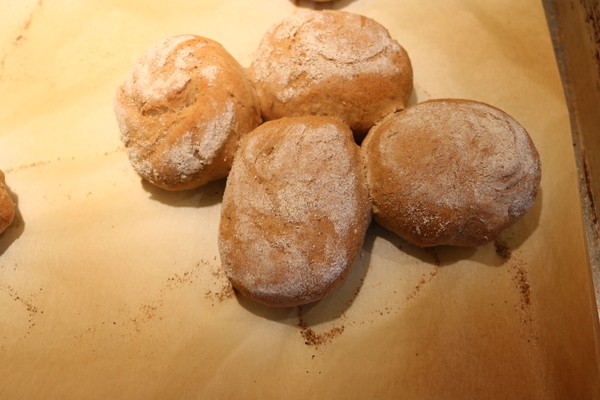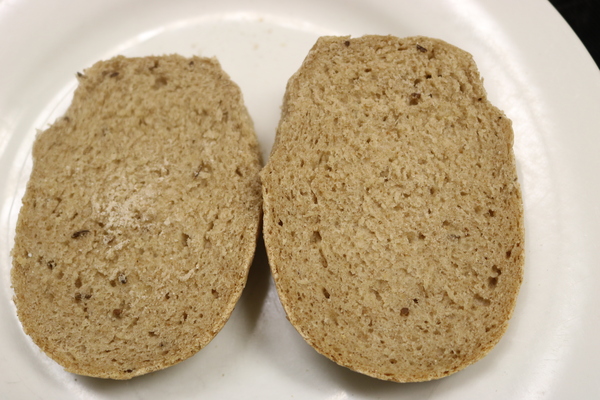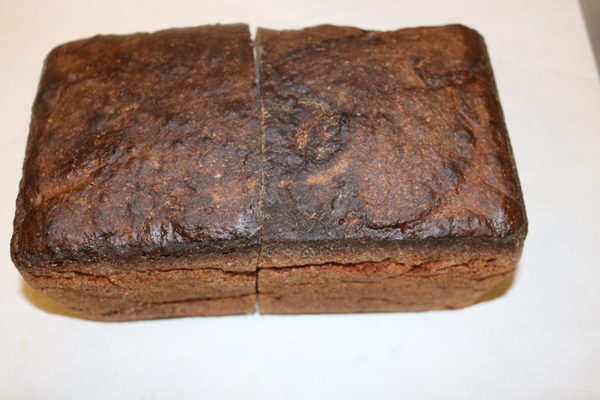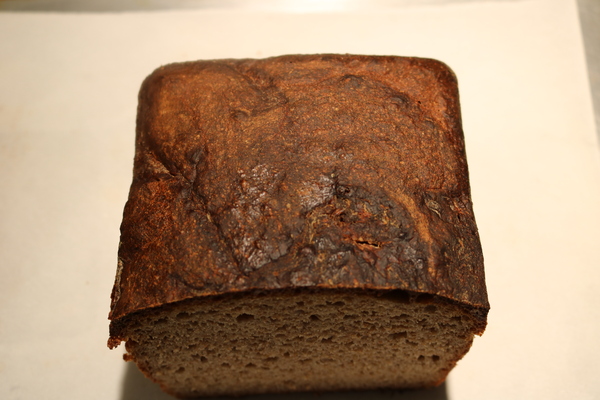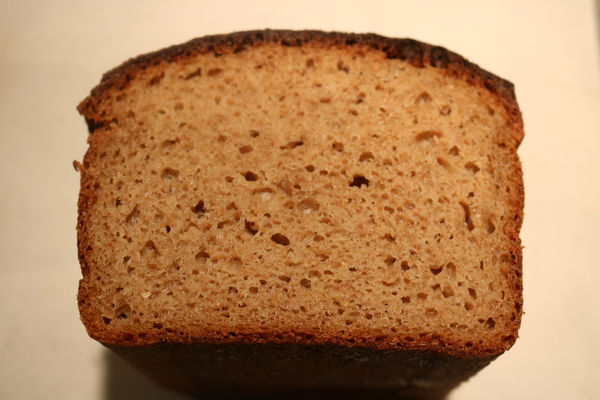Home › Forums › Baking — Breads and Rolls › Coming Through the Rye
- This topic has 138 replies, 11 voices, and was last updated 3 years, 1 month ago by
Mike Nolan.
-
AuthorPosts
-
January 24, 2020 at 8:42 pm #20655
I'm in a peculiar position, as the kneading spiral on my 7-qt mixer works better with big batches. (I'd love to know if someone with the small Cuisinart mixer has better success.) The used bread machine--for mixing and kneading only, as I don't let the dough rise in it--gave me a cheaper option than investing in a smaller mixer. I preferred the texture of the bread that was kneaded in the Zo than the first loaf, where I was constantly having to stop the mixer and adjust the dough.
I might try mixing with the paddle before switching to the dough hook, which is what I do with all of the other breads I bake.
-
This reply was modified 5 years, 5 months ago by
BakerAunt.
January 24, 2020 at 8:54 pm #20657I've got a 4 1/2 quart KA (from the early 70's), so when I get to that one I'll be able to report on how well it works. I've heard from several people with larger capacity mixers (like the Anksarsrum) who said they had problems with smaller batches.
I haven't decided on an order yet for the 78 recipes in TRB, so I will probably be skipping around a bit, as it doesn't make a lot of sense to me to make two similar recipes back-to-back. A fellow BBGA member contacted me to say he was having some problems with a couple of Ginsberg's recipes, I may try one of those soon.
I think I'm doing the Munich Penny Rolls next, just because they're rolls not loaves, and Ginsberg says they have a thin crisp exterior. (My Holy Grail of breads remains the rolls I had in NYC around 25 years ago, with a crust like an eggshell and a creamy interior. I think they had some rye content, too.)
January 25, 2020 at 6:09 am #20661Once again, thanks for the starter tips.
Mike, BA, what are you using for steam for your rye? Reading Ginsberg and others, this seems to be important for rye and whole wheat. Does steam matter less if you're baking in a pan than freeform?
January 25, 2020 at 7:00 am #20662I have two old (pre-Whirlpool) KA mixers. I have my original which is a 4.5 quart but will fit a 5 quart bowl. I was making a batch of stiff bread and it started to smoke. It still works but smells like smoke when I use it. I also have a hand mixer of the same vintage that came with two beaters, an immersion blender attachment, and a dough hook. It actually works and is a nice alternative to pulling out my stand mixer.
I asked for a bigger one for father's day and was given a five quart which is not significantly bigger but has a more powerful motor. It still overflows with anything more than five cups of flour even though it was rated to nine cups (says it on the manual). The engine will handle bigger loads than the 4.5 but it still overflows.
Interestingly at the restaurant they have a 10 quart which is what I use most of the time. It is not a KA or Hobart. I believe it's a Vollrath which I'd never heard of before. While it will mix 10 lbs of bread dough if I try to do it on anything other than low speed it shuts down and has to be reset.
Then there is the 35 qt Hobart! But the bowl, by itself, weighs a ton let alone filled with dough. So unless I need it (like for 35 lbs of challah) I don't use it. The restaurant uses it exclusively for making pita.
January 25, 2020 at 8:34 am #20664Mike and Arron--Thanks for your comments on the mixer bowl size's relationship to the amount of dough. I've always thought that an ideal home mixer would have attachments that allowed for smaller and larger projects. It would save money and precious kitchen space. When I brought home the second used bread machine, I initially had no idea where I would put it, but I was able to stash it on the counter in a long narrow space that I'd not find a way to use. I still have to move it to use it, but at least it's out of the way.
Aaron--none of the Ginsberg recipes that I've baked require steam. The last bread said to brush the top with water. I settled for spritzing it well with water.
I did in the past bake some breads with steam, but I'm not sure that I did it properly, and a pan that I used developed a problem from the salt in west Texas waster. I'd like to try the steam again. I had bought a set of iron barbecue steamers (long narrow--about 2 inches wide--cast iron with grilled tops. These were recommended by someone on the now defunct KAF baking circle, but I didn't get a chance to try them. Maybe it's time to see how well they work. I also recall someone who would throw ice cubes into a hot iron pan. Ice cubes might work well with these.
When I was trying to use steam, I was also letting the bread rise in a basket and turning it out onto a cornmeal lined paddle, which I would then try to get it to slide off onto a pre-heated stone in the oven. I became tired of 1)deflating the loaf, even a bit, and 2)cleaning up the mess that the cornmeal left in the oven, especially after I had an oven that could not have a liner on the bottom.
What I would do now is use parchment, as I do for pizza. I'm going to have to try all of this again, although I've decided my next bread is going to be two loaves in regular pans so that I can stick one in the freezer.
January 25, 2020 at 10:48 am #20667I've tried a variety of steam methods over the years. What I've been doing lately is putting an 8" cast iron skillet in the oven when I turn it on, then I put the tea kettle on the stove. When the dough goes in the oven, I pour a cup or so of boiling water in the skillet. There's a big burst of steam, but much of it comes out the open door, I think. So I also take a sprayer and spray the side walls of the oven.
I believe steam is even more important for free-form loaves, because there's a lot more dough surface area exposed to the open air, so there's more crust for the steam to impact.
Several years ago I read something about a kit someone was selling that consisted of a heat-safe plastic tube that would attach to the oven door and lead down to a heavy metal pan inside, you could pour water in it and it would go into the pan while the oven was (mostly) closed. I assume it had some kind of funnel. I haven't found that reference lately. What I wasn't sure about is whether you took the tube out a few minutes later or if the oven door wound up being propped slightly open as a result.
Several companies make a steam oven for home use, they're expensive and the reviews I've seen of them have been mixed. (Maybe it is just getting used to a new oven.) But I have no plans to replace my 48" DCS dual fuel range any time, and it'd be a major job anyway, we'd probably have to take out the center island temporarily.
As I understand it, steam injectors in commercial ovens require periodic maintenance, cleaning out calcium buildup, etc. I assume there would be some ongoing maintenance on a home steam oven as well.
My KA is making some noises every now and then that tell me the main gear may be going. I don't know if I can get a replacement for it, since we've had it since 1972. (It was a wedding present.)
I've thought quite a bit about what to replace it with.
KA makes several lines of mixers in each of their sizes, with different quality/durability levels, I'm sure. You probably have to check the motor rating to figure out which one it is. (Price is probably a good clue, too, if it is under $200 it probably isn't going to be the strongest motor.) From reviews on various sites, it seems KA has gone back to metal gears from the plastic ones, at least in some lines.
KA also now offers a glass bowl option for their smaller mixers, but I hear it is very heavy and the base tends to chip where it hooks in, so I'm not sure it is worth the cost.
Viking used to make an 8 quart mixer that got good reviews (they're what KAF had in their test kitchen when I visited it several years ago.) But they've gone out of the business. I've looked at a 12 quart commercial-grade countertop mixer a few times, but it's in the $1000 range.
I've also looked at the Anksarsrum and similar mixers, I think I'd like to work with one before actually buying one.
Not sure where I'd find the counter space, but if I had to replace it NOW and funds weren't a major object, I might go with a cheaper 4 1/2 or 5 quart KA just so I've got one for small batches and the 12 quart one for bigger stuff. That way I'd still be able to use my KA pasta attachments and the bowls I have.
Has anybody tried the KA attachments on other brands of mixers that have an attachment port?
I've made recipes that were in the 9 cup range in my 4 1/2 quart mixer, but what you have to do is add the flour and water in several stages so it doesn't slop over the side. Larger mixers tend to have a bowl shield that probably helps prevent spillovers. If you're doing a dough with a preferment (and I do a lot of those, especially the rye breads), you might have to add the preferment in several stages as well.
January 26, 2020 at 7:17 pm #20730Report on Munich Penny Rolls (The Rye Baker pps 198-201):
This recipe made 16 rolls about 3 1/2 by 2 1/2 by 1 1/2 inches, with a variance of about 1/4 inch. They weighed 75 grams each (2.65 ounces).
This is one of the recipes in The Rye Baker that lists first clear flour as an option in place of bread flour, and I used first clear flour in it. My experiences with other breads using first clear flour seem to suggest those breads can go moldy faster than ones made with bread flour, I don't know if that will be the case here yet.
It calls for red rye malt, which you make by toasting rye malt. I got some chopped rye malt from a home brew supply store and ran it through my impact mill before toasting it.
I had to add about 1/3 to 1/2 cup more of both rye and wheat flour than the recipe called for, not sure if that was a liquid measurement issue, and it took a while before the dough came together. This is the first recipe I've made where the scale weight (83 grams each) was above that suggested in the recipe. It didn't pull a very good windowpane, but it was pretty stiff after about 10 minutes of machine kneading, so I declared it ready. It rose well both in the bulk rising and after scaling and shaping.
The rolls are baked in sets of four arranged as shown in the top picture. Ginsberg calls this a herringbone.
They're a bit milder in flavor than I was expecting, but they taste very good plain, with a little butter, or as a sandwich roll. I haven't tried toasting them yet. I was expecting more of a crisp outer crust, it is stiff and a bit chewy (like a lot of sourdough breads), but not really crisp. Maybe they'll crisp up some overnight.
I would make these again.
Attachments:
You must be logged in to view attached files.January 26, 2020 at 11:04 pm #20736Your rolls look nice Mike.
January 26, 2020 at 11:46 pm #20740Mike, those rolls look real nice.
January 27, 2020 at 7:42 am #20743One of the many things, I don't understand about rye flour, is what does the Ash content measure? Is it a measure of protein or minerals? How do they get that figure.
January 27, 2020 at 9:00 am #20751Ash content is measured by burning the flour and measuring how much ash is left over. The ash comes mainly from the bran, germ and outer part of the endosperm.
If a flour is 100% starch from the inner endosperm, the ash content is low, Calvel's book says the finest quality French flours, type 45, have an ash rate below 0.5% while whole meal flour is over 1.4%. Removing all the bran and germ is essentially impossible, no matter how finely you separate it (called bolting, because it originally used bolts of cloth), there's always going to be a little bran or germ left in the flour. So it measures the extent to which the flour is refined.
Another way to think of ash rate is as the opposite of extraction rate, how much flour is extracted from the wheat berry, type 45 French flour or American patent flour has an extraction rate around 65%, a whole meal flour is in theory 100% extraction, but in practice more like 90-98% due to removing broken or immature berries, stones, twigs, etc. from the grain before grinding it.
Since rye is not white in the middle, there isn't as much cosmetic value in extracting only the endosperm, so most rye flours are medium or dark flours. White rye flour is only the endosperm (or as little bran and germ as possible), and it isn't all that white.
February 2, 2020 at 6:12 pm #20948Report on Frisian Rye Bread (The Rye Baker, pps 184-186):
I forgot to take a picture of the whole loaf before cutting a slice, but it was made in a 9x5 loaf pan and is about 3 3/4 inches high. The recipe made one loaf that weighed about 1100 grams. It can be sliced fairly thin, a slice is between 40 and 50 grams.
The top is quite dark compared to the interior, so I've provided a shot showing the exterior and both the interior and top:
When it first came out of the oven there were distinct notes of molasses in the bread, though there's no molasses in the recipe, but that faded somewhat overnight.
I did tinker with the recipe a bit, because I have nearly 1200 grams of sour rye starter that was discarded during feedings. So rather than build the first level sponge using fresh rye flour inoculated with a little of the rye sour, I took about 360 grams of the discards and added water to match the amount of flour and water in the formula. It was a little slow to rise (having just come out of the refrigerator), so I added a little more rye sour the next morning and let it sit until the following morning, by which time it was sufficiently active. The second stage sponge seemed to perform as the recipe suggested it should, and the dough was like a very thick batter after 8 minutes of kneading, which was also how I expected it to be.
This recipe starts out in a cold oven, with the temperature turned down 20 minutes after the oven is at the initial temperature setting, so it doesn't use steam. The loaf cooled for 24 hours before it was sliced, per the instructions.
The interior is more moist than I thought it would be, even though the interior temperature was over 205 degrees when I took it out. It might have benefited from another 10-20 minutes in the oven.
There's a very assertive sour flavor to it, which doesn't really go away when the bread is toasted. How much my tinkering with the recipe, using over 360 grams of 'discarded' rye sour, is unclear, I may have to make this recipe a second time at some point.
Toasting it doesn't appreciably change the flavor, but a buttered slice of it (untoasted) paired very well with baked pork-n-beans. I tried spreading some of the cheese dip on a slice, it went well, too.
Attachments:
You must be logged in to view attached files.February 2, 2020 at 7:10 pm #20957Beautiful, Mike! I don't understand -- why does it have to rest for 24 hours before slicing?
February 2, 2020 at 7:19 pm #20959That's true of a lot of the recipes in Ginsberg's book, high rye content breads have a tendency to be a bit gummy right after baking due to a lot of amylase activity, since there isn't a gluten network supporting the bread. The extra resting time gives the interior starches time to gel up more and the moisture levels even out a bit. Some of the recipes are not supposed to be cut into for two days.
I think this bread is pretty good if you like a fairly sour rye, and I suspect it will be even better in a day or two if it dries out a little more.
February 2, 2020 at 9:50 pm #20965Nice bread Mike,thanks for all the information about the rye bread.
-
This reply was modified 5 years, 5 months ago by
-
AuthorPosts
- You must be logged in to reply to this topic.
